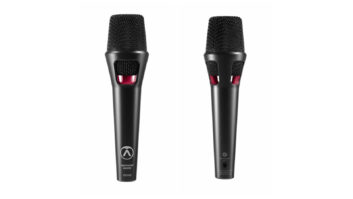Mixing amateur vocalists with a technology-laden worship sound system can be a recipe for disaster, but even a vocalist inexperienced with mic handling can be taught a few basic skills that can avoid technical distractions during worship.
With the explosion of contemporary worship over the last decade or so, it could be easy to assume that everyone involved in leading worship has experience in the fundamentals of sound reinforcement and the technologies involved. To assume that would be unfair, and the assumption can lead to misunderstandings and a compromise in the worship experience.
For affirmation of the issues that seem to be most common, I turned to a group of church audio folks who inhabit a social media group called “Church Sound Media Techs” on Facebook—nearly 5,700 members that share information, problems, solutions and encouragement. I also reached out to a few seasoned professional engineers for training tips for less-seasoned vocalists. The three biggest issues that emerged are the “psychology” of amplified singing, monitoring issues and microphone technique.
WHERE DID THEY LEARN TO SING?
The psychology of singing is challenging. As an engineer and producer, I’ve found that I serve my role most effectively when I place myself in the performers’ spot for a moment. Most vocalists in the church are non-professionals, and their typical background is ensemble vocal training learned in school; they are trained to “blend” by listening in a non-amplified setting. The individual microphone, sound reinforcement and amplified monitors are completely foreign to their previous experience, so it’s easy to understand how they feel like “fish out of water.” Also, it’s worth remembering that many of the solo vocalists have been promoted out of the church choir, so their most recent vocal experience has been focused on acoustic blend.
“I CAN’T HEAR MYSELF”
Here’s another challenging situation that has to be addressed with great discernment and gentle spirit. Often, a difficult cycle begins with the request for more monitor level from a vocalist with sometimes-counterproductive results, as the vocalist sings softer to try to “mix” their voice into what they are hearing. This can lead to a variety of technical challenges, most often in the form of feedback. As sound technicians, we can help our teams be more consistent by discussing this natural inclination, and encouraging them with the fact that strong, consistent level is what is needed; the engineer will handle the vocal and instrumental “balance.”
THE FLASHLIGHT TECHNIQUE
Microphone technique is often a huge challenge, and sometimes we take it for granted that our vocalists understand the problem they unintentionally create. My good friend Curtis Flatt is a veteran engineer with an enviable resume. He shared a tip he’s used in training vocal teams that I thought was very ingenious. “I have found that so many talented vocalists have learned their technique from TV, where you keep the mic low for camera shots. At a couple of churches, I have trained with a flashlight. Hold it like your mic, and if the light isn’t in your mouth completely (or mostly), then the tool being used (the microphone) isn’t being used to it’s full potential. The visual actually helped.” Several other church sound techs quickly confirmed that this was also a huge issue. Scott in Minnesota said, “Your lips should be touching the grill. I disinfect them before/ after every performance, and sanitize the grills in 180-degree water once a week— there are no germs. If you’re too loud, we WILL turn you down, trust me.” Greg in Indiana said, “I want to see lipstick on the grill”. (Unless it’s a guy’s mic, right Greg?)
It takes continual encouragement and coaching to help train worship vocalists to be consistently aware of microphone position. Nothing is worse than a vocalist “dumping” their mic straight into the monitor at their feet in the midst of a powerful worship moment.
Harold Rubens knows a thing or two about church audio. Prior to his current role as FOH Engineer for Steven Curtis Chapman, Rubens was the head of the Audio Department at Houston’s Second Baptist Church, a mega-church by anyone’s measure, with a high-evolved technical audio and video production environment and staff. With HOW vocalists, he said, “Despite all the experience and tools that I have, the one thing that will destroy any chance a vocal has to have authority, power, clarity and character is improper microphone technique. If you are a professional singer/artist, and you give me a good signal to work with, I can enhance that vocal signal with effects and compression and EQ to sound great in relation to everything else in the mix. Even if you are an amateur or a “weekend warrior” type singer and you give me a good signal, I can do wonders with it. However, no matter your experience level as a singer, if you don’t give me a good signal to work with, I will [need an arsenal of tools] to fix problems rather than enhance a vocal.”
He goes on to say, “To define good microphone technique (for most live stage microphones situations), I would say this: 1. Sing into the top of the microphone, not across the top of it or into the side of the mic (don’t listen to video directors who say that the microphone covers your face.) 2. Sing with good volume and project past the microphone (pretend you are singing to the room without a mic). 3. The closer to the microphone your mouth is, the better (If you have to deal with “hygiene” issues, pull back no more than two fingers away from the top of the mic). The farther your mic is from your mouth, the less of your voice I get and more of the stage noise bleeds into the microphone, which introduces all sorts of problems with clarity, monitors and feedback.”
TURN TO THE EXPERTS
For tips and resources on proper mic technique, I decided to turn to the experts. And who better than the people who make them?
Audio-Technica has been kind enough to create a section on its website dedicated to microphone selection and use for Houses of Worship (http://x.co/5jjyH). The information might seem a bit obvious or fundamental to more experienced church sound techs, but can provide a great primer for your worship team or new tech volunteers.
Shure also has some very valuable teaching materials on both its website and the Shure blog (www.blog.shure.com). There are a good number of articles to be found in the Education section. I find it’s helpful to read as many as possible, because while not every technique works in every instance, a broad group of views will give me several perspectives on approaching any given challenge.
One of the best resources I’ve found is from Audix, another top-quality microphone manufacturer. Its website has several instructional videos on vocal technique (http://x.co/5jjyd) that would be extremely useful to educating your worship team vocalists. With three videos and 15 minutes, everyone will have the fundamentals of good mic technique, and a great starter for a team conversation that will lead to more unity and understanding between the entire team. I recommend that you get your team together before the start of your next worship rehearsal and watch these together.
Ultimately, the quality of your sound depends first and foremost on one thing—a great source. By working with your worship vocalists to give you great “source”—singing with confidence and with consistent technique—they will have a more comfortable environment and you should have an easier time creating a satisfying musical experience for your congregation.
Eric Elwell, a 25-year veteran engineer with studio, broadcast and live-concert mixing experience, is now a project developer for A/V integrator Technical Innovation.






